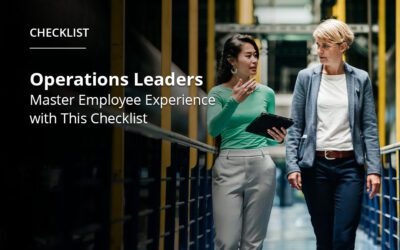Minimum Wage Hikes: 3 Productivity Strategies to Offset Those Extra Costs

If your payroll increases, don’t raise your prices or lay off hourly employees. Instead, get productive and draw the most out of your workforce. Here’s how…
Articles about the economics of minimum wage increases have been written a thousand times over by countless political pundits and reporters. As it turns out, economists have been debating the large-scale impact of mandatory minimum wage hikes for years—and the lack of consensus has proven exhausting.
“I get sick to my stomach,” said Dan Hamermesh, an economist, in a 2014 interview with NPR about the ceaseless, polarizing debate. “It just keeps on going on, so I’m bored and annoyed.”
Over five years later, Hamermesh’s disheartened words still ring true as the decades-old dispute persists without accord.
An economist might be over it, but if you’re an employer of hourly workers…wage increases affect your business. Whether you personally support or oppose the Fight for $15, the results are in: cities and states across the U.S. are committed to a hike.
What, then, are the consequences of these laws? More specifically, how will employers cover the extra money they’re being mandated to spend on payroll?
Let’s look at several key options: the good, bad, and the ugly…
1. The Bad: Raise prices.
If operating costs go up, businesses can choose to pass them onto the consumer.
Smaller employers with lower profits will be disproportionately affected by the mandated increase in labor spend, and an increase in prices may drive loyal customers to look for business elsewhere.
Although it was widely speculated that this would happen in Seattle—where the minimum wage was set to phase to $15 an hour by 2021—no significant evidence of price increases on goods like local supermarket food were associated with the minimum wage ordinance. However, some local businesses have reported the need to raise prices for the first time in history due to the cost of labor alone.
2. The Ugly: Layoffs.
With payroll being most organizations’ largest expense, businesses with tight compensation budgets may reduce the amount of scheduled working hours or resort to layoffs when faced with increased labor costs, curtailing job growth and pressuring the unemployment system.
“You have to be a bit careful,” says Bill Gates, “If you raise the minimum wage, you’re encouraging labor substitution and you’re going to go buy machines and automate things.” And that’s precisely what many companies either have done already or are planning to do soon.
A more expensive price tag on low-skilled workers makes them an easy target for getting replaced by robots, apps, and order kiosks that can do their job for less. Large employers like McDonalds, Panera Bread, Chili’s, and Whole Foods are just a few among many chain brands to have already implemented powerful forms of automation, including self-ordering kiosks and self-driving shopping carts designed to perform tasks that were once reserved for people.
But what if instead of automating human duties, we automated the processes that enable people to work smarter and more efficiently in order to cover more ground in fewer steps?
How would that work? Let’s find out…
3. The Good: Get productive.
Employers affected by minimum wage increases don’t have to balloon their prices or layoff loyal, valuable employees to make themselves whole. Identifying opportunities to improve efficiency and productivity will allow businesses to maintain a strong value proposition, which will help them keep a competitive advantage in their space.
Before committing to any measures that could ultimately degrade your brand’s reputation and value, consider these 3 proven strategies:
a. Calculate and respect customer demand.
Every modern retail store in the world collects data. Traffic data, point-of-sale data, and an array of metrics that indicate when people are shopping and how much they’re spending in a particular store.
Retailers that analyze these numbers are rewarded with a customer demand synopsis, which can then be used to calculate a store’s necessary employee count per shift.
Knowing exactly how many associates you need at any given point in time is fundamental to reducing unnecessary overtime, preventing overstaffing practices, and keeping employees engaged—all factors that keep your payroll costs low. If you want to protect your bottom line in the face of growing wages, start with labor forecasting.
b. Enable cross-staffing.
In other words, get flexible with your employee roles and responsibilities. Let’s use Erica and Jay, two full-time hourly employees at a major hotel chain, as examples.
Jay and Erica work as team manning the front desk, accommodating customers over the phone and in-person. They’re constantly busy, except on weekdays from noon to about 2 PM when there’s a lull in traffic. Instead of keeping the front desk overstaffed for 10-14 hours a week, the hotel manager can move Jay to the gift shop or the restaurant during the downtime to get the most out of his billable hours.
Cross-staffing also offers employees the opportunity for growth by widening their professional skillset.
c. Offer shorter shifts at a premium.
This strategy is all about aligning employee worktime with required workload.
Imagine, for example, that the owner of Bubba Shrubs Landscaping Co. needs his team to only work 6 hours on Monday, and not the usual 8. Instead of paying each landscaper a full day’s wage at $15 per hour ($120/employee), the owner could offer to compensate those 6 hours at a premium rate of, say, $18 ($108/employee).
It’s a simple yet effective compromise, one that drives flexibility and typically leaves both parties satisfied with their end of the bargain. That said, it does present challenges, especially for larger organizations attempting to scale the process—but automation software can make that easier.
Ready or not, the hikes are coming…
Moving forward, the most successful businesses will adopt a combination of creative strategies, matching labor to customer demand while increasing employee flexibility for a seamless transition into modern hourly wage dynamics. Will you?
Subscribe to The WorkForce Blog
Learn the art and science of maintaining productive, happy, engaged employees.
Discover More
Nucleus Insights from WorkForce Customers Research Note
Nucleus Research interviews WorkForce customers who validate why we’re ranked the #1 WFM enterprise vendor for 10 consecutive years.
Elevate Employee Experience: Checklist for Operational Leaders
Get the practical steps and technology functionalities operation leaders need to improve their employees’ work experiences.
Streamlining Complex Workforce Compliance Requirements Boosts Productivity
Discover how workforce compliance software helps EMEA organisations navigate complex legislation, enhance compliance and boost operational efficiency.




